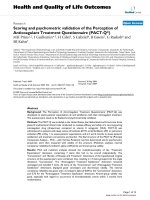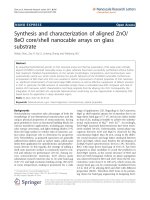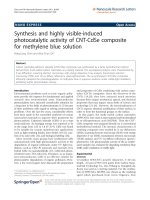Báo cáo hóa học: " Synthesis and Tribological Properties of WSe2 Nanorods" ppt
Bạn đang xem bản rút gọn của tài liệu. Xem và tải ngay bản đầy đủ của tài liệu tại đây (349.97 KB, 5 trang )
NANO EXPRESS
Synthesis and Tribological Properties of WSe
2
Nanorods
Jinghai Yang Æ Haixia Yao Æ Yanqing Liu Æ
Yongjun Zhang
Received: 10 July 2008 / Accepted: 2 October 2008 /Published online: 25 October 2008
Ó to the authors 2008
Abstract The WSe
2
nanorods were synthesized via solid-
state reaction method and characterized by X-ray diffrac-
tometer, TEM, and HRTEM. The results indicated the
WSe
2
compounds had rod-like structures with diameters of
10–50 nm and lengths of 100–400 nm, and the growth
process of WSe
2
nanorods was discussed on the basis of the
experimental facts. The tribological properties of WSe
2
nanorods as additives in HVI500 base oil were investigated
by UMT-2 multispecimen tribotester. Under the determi-
nate conditions, the friction coefficient of the base oil
containing WSe
2
nanorods was lower than that of the base
oil, and decreased with increasing mass fraction of WSe
2
nanorods when it was \7 wt.%. Moreover, the base oil
with the additives was rather suited to high load and high
rotating speed. A combination of rolling friction, sliding
friction, and stable tribofilm on the rubbing surface could
explain the good friction and wear properties of WSe
2
nanorods as additives.
Keywords WSe
2
nanorods Á Growth mechanism Á
Lubrication additive Á Tribological properties Á
Rotating speed
Introduction
The transition-metal dichalcogenides (including disulfide
and diselenium) showed a wide variety of interesting
physical properties, such as semiconducting, metallic,
superconducting, and magnetic behavior [1–7]. WSe
2
was
an interesting member of the transition-metal dichalcoge-
nides family. It was a semiconductor with a band gap in the
range of 1.2–2 eV, which was useful for photovoltaic and
optoelectronic applications [8–10]. WSe
2
possessed a lay-
ered structure with the metal atoms (W) bonded covalently
between the layers of chalcogen atoms (Se), and the
remarkable feature of the WSe
2
was highly antiphotocor-
rosive due to the observation of layered structure, which
made it as a strong candidate in the development of high
efficiency photoelectrochemical solar cells [11].
In the past few decades, the disulfides, such as MoS
2
and
WS
2
, had been extensively studied as lubrication additive
on reducing friction and wear of rubbing pairs [12, 13]. The
friction-and-wear mechanism had been discussed in great
detail [14–19]. However, little work focused on the prep-
aration of WSe
2
nanorods, which was similar to the WS
2
nanorods, especially the tribological properties of WSe
2
as
lubrication additive.
In this study, we reported a simple and benign method to
prepare WSe
2
nanorods using W and Se (mole ratio 1:3) at
800 ° C in an argon atmosphere. Moreover, the tribological
properties of WSe
2
nanorods as additives in the HVI500
base oil were also investigated.
Experimental
Preparation of WSe
2
Nanorods
All chemicals used in the experiment were from state
reagent without any further purification. In a typical pro-
cedure, high-purity tungsten, selenium powders (mole ratio
W:Se = 1:3), and agate balls with diameter of 8 mm were
mixed in an agate jar and mechanically milled with QM-
ISP2 apparatus for 50 h at 450 rpm. After ball milling, the
J. Yang (&) Á H. Yao Á Y. Liu Á Y. Zhang
The Institute of Condensed State Physics, Jilin Normal
University, Siping, China
e-mail:
123
Nanoscale Res Lett (2008) 3:481–485
DOI 10.1007/s11671-008-9183-8
mixture was pressed into cylindrical pellets with omnipo-
tence tester (CSS44100, ChangChun, China). The pellets
were put into a conventional tube furnace, and heated up
800 ° C for 1 h followed the argon flow at the rate of about
20 sccm before cooling to the room temperature.
Structural characterization was performed by X-ray
diffractometer (XRD) on D/max-2500 copper rotating-
anode XRD with Cu Ka radiation (k = 1.5406 A
˚
)at
40 kV, 200 mA. The morphology and structure of samples
was determined using TEM (JEM-2100HR, Japan) at
200 keV. The composition was characterized by energy
dispersive X-ray spectroscopy (EDX, S-570, and Japan).
Tribological Properties of WSe
2
Nanorods
as Lubrication Additive
Different mass fractions of WSe
2
nanorods were dispersed
in the HVI500 base oil with ultrasonic vibration (1800 W
power, 2000 Hz frequency) for 5 h without any active
reagent, and then a series of suspended oil samples were
obtained. The tribological properties of the base oil con-
taining WSe
2
nanorods and the base oil were investigated
using a ball-on-disk mode of UMT multispecimen tribo-
tester at ambient condition. The morphology of the wear
scar was examined using a Metallurgical microscope
(MBA21000, Japan).
Results and Discussions
Characterization of WSe
2
Nanorods
The XRD pattern of WSe
2
nanorods is illustrated in
Fig. 1a. All peaks were indexed to the hexagonal WSe
2
(JCPDS No. 38-1388), which indicated the high purity of
the obtained WSe
2
nanorods. Figure 1b shows the shifted
(002) peak caused by the crystal defects and strains [20].
Moreover, all peaks were not obviously widened from
XRD pattern. The EDS results gave a W:Se ratio about 1:2,
so the sample was confirmed to be WSe
2
.
Figure 2 shows the TEM patterns of WSe
2
nanorods.
Figure 2a indicated that the diameters of WSe
2
nanorods
were from 10 to 50 nm, and the lengths were hundreds of
nanometers. At the same time, Fig. 2a also reveals that the
nanorods have a sharp top and unsmooth trunk, which is
different from the WS
2
nanorods obtained by self-trans-
formation process [21]. Further observation showed the top
of the short nanorods joined at different angles as shown in
Fig. 2a (area f, e). The special structure might be due to the
unsaturated dangling bonds of the top, which combined
with each other under a high temperature. Figure 2b dis-
plays a single WSe
2
nanorod with diameter of 6 nm. The
HRTEM image shows the d-spacing between two adjacent
layers was 6.54 A
˚
corresponding to the (002) plane.
Moreover, different folding stages of samples were
observed at regions marked A, B, and C (Fig. 2c), the
WSe
2
nanorods were formed at last.
The reported growth mechanism in literatures [22, 23],
especially the solid-state reaction of MoS
2
nanostructure,
gave us much inspiration toward understanding the for-
mation of WSe
2
nanorods. Under the high temperature
conditions, Se quickly evaporated and simultaneously
reacted with W. This rapid reaction might lead to super-
saturation and fast nucleation. Thus, numerous nuclei of
WSe
2
were initially formed in the vapor phase. When the
initial clusters grew to the critical size, they began to form
crystal flakes. Because of the instability of unsaturated
dangling bonds, crystalline sheets began folding, and the
dangling bonds of self-terminated planes stabilized into
spherical or cylindrical crystal shapes. Thin-folded flakes
could directly roll up and adopt the rod-like structure
(Fig. 2c).
Effect of WSe
2
Nanorods on Tribological Properties
Figure 3 shows the friction coefficient as a function of time
with 2 N load and 150 rpm rotating speed. The average
friction coefficient of 7 wt.% WSe
2
nanorods (Fig. 3b) was
close to 0.063, whereas it was 0.116 for the HVI500 base
oil (Fig. 3a). That meant the addition of WSe
2
nanorods to
the base oil resulted in nearly 50% reduction for the friction
coefficient of the base oil. The wear scar of plate after
rubbing is shown in Fig. 4a (the base oil) and Fig. 4b (the
base oil containing WSe
2
nanorods). It could easily be
found from Fig. 4a that wear scar has evidently rough,
thick, and deep furrows and the width of about 0.18 mm.
Compared to the wear scar of the base oil, the wear scar
20
12 14
2θ(deg)
Intensity(a.u.)
(b)
(a)
Intensity( a.u.)
2θ(deg)
008
101
118
205
116
203
200
112
110
105
006
103
100
002
40 60 80
13 15
Fig. 1 XRD pattern of the WSe
2
nanorods
482 Nanoscale Res Lett (2008) 3:481–485
123
was flat and smooth, and the width was only 0.06 mm as in
Fig. 4b. For other materials, such as MoS
2
micrometer
spheres [24], the lowest friction coefficient was only 0.08,
and the wear scars of MoSe
2
and WS
2
[25] have evidently
thick and deep furrows different from that of the WSe
2
nanorods we synthesized.
Figure 5a shows the friction coefficient as a function of
concentration of the WSe
2
nanorods from 2 to 7 wt.% at
200 N load and 300 rpm rotating speed. For any mass
fraction \7 wt.%, the friction coefficient of the base oil
containing WSe
2
nanorods was lower than that of the base
oil, and decreased with increasing mass fraction of the
additives. Figure 5b shows the impact of rotating speed and
load for the base oil containing 7 wt.% WSe
2
nanorods.
Obviously, under low rotating speed, the friction coeffi-
cient at low load was lower than that at high load. But
under high rotating speed, the friction coefficient at high
load decreased. In other words, the base oil containing the
additives was rather suitable for high loads and high
rotating speeds.
From the above results, WSe
2
nanorods as lubrication
additive could improve tribological properties of the base
oil. A rolling friction mechanism could explain the excel-
lent tribological properties of nanoparticles as lubrication
additive. In this study, the effect WSe
2
nanorods as lubri-
cation additive could be attribute to the molecule bearing
Fig. 2 a TEM image of WSe
2
nanorods. b HRTEM image of
single WSe
2
nanorod. c TEM
image of WSe
2
layers at
different folding stages
0
0.05
0.06
0.07
0.08
0.09
0.10
0.11
0.12
0.13
0.14
0.15
0.16
0.17
0.18
0.19
0.20
0.21
(b) HVI500+WSe
2
(a) HVI500
Friction coefficient
Time (s)
200
400 600 800
1000
1200 1400 1600
1800
2000
Fig. 3 Variation of friction coefficients for the HVI500 base oil and
the HVI500 base oil containing 7 wt.% WSe
2
nnaorods
Nanoscale Res Lett (2008) 3:481–485 483
123
mechanism of rolling friction and sliding friction of the
WSe
2
nanorods between the rubbing surfaces. In addition,
rotating speed was very important in the experimental
process. Under low rotating speed, the stability of liquid
lubricant reduced, the load almost acted on protruding part
of rubbing surfaces. When the load was increased, the
lubricant film became unstable and easily splintered, the
friction coefficient became high, as shown in Fig. 5b. But
with the increase of rotating speed, the oil film became
more and more stable, which could not only bear the load
of the steel balls but also prevented any direct contact
between the two rubbing surfaces. Moreover, when the
shape of nonmaterial was destroyed at high load and high
rotating speed, exfoliation of nonmaterial layer filled the
rough contact surface and formed a stable thin film with
base oil, which could decrease friction and wear happening
on the rubbing surfaces.
Conclusions
WSe
2
nanorods of 10–50 nm in diameters and 100–400 nm
in lengths were prepared successfully by solid-state reac-
tion of the tungsten and selenium powders. The HVI500
base oil with addition of WSe
2
nanorods showed the best
friction-and-wear properties. Tribological experiments
indicated that the effect of WSe
2
nanorods as lubrication
additive could be attribute to the molecule-bearing mech-
anism of rolling friction and the sliding friction of the
WSe
2
nanorods between the rubbing surfaces. Moreover, a
stable film on the rubbing surface could not only bear the
load of the steel ball but also prevent any direct contact
between the two rubbing surfaces.
Acknowledgments This study is supported by the National Natural
Science Foundation of China (Grant Nos. 60778040, 10804036,
60878039), the Science and Technology Bureau of Key Program for
Ministry of Education (Item No. 207025), and the Development of the
Science and Technology Planning Project of Jilin province (Item No.
20070514).
References
1. N.D. Boscher, C.J. Carmalt, I.P. Parkin, J. Mater. Chem. 16, 122
(2006). doi:10.1039/b514440j
Fig. 4 The wear scar of plate: a
HVI500 base oil, b HVI500
base oil containing WSe
2
nanorods
100
0.080
0.085
0.090
0.095
0.100
0.105
0.110
0.115
0.120
0.125
(a)
Friction coefficient
Rotating speed
HVI500
HVI500 + 2% WSe
2
HVI500 + 5% WSe
2
HVI500 + 7% WSe
2
0.080
0.082
0.084
0.086
0.088
0.090
0.092
0.094
0.096
0.098
0.100
0.102
0.104
0.106
0.108
0.110
0.112
0.114
0.116
(b)
Fiction coefficient
Rotating speed
100N
200N
300N
150 200 250
300
350
400
100 150
200 250
300
Fig. 5 Variation of friction coefficient as a function of rotating speed
for a the HVI500 base oil and the HVI500 base oil containing 2, 5,
7 wt.% WSe
2
nanorods at 200 N, b the HVI500 base oil containing
7 wt.% WSe
2
nanorods for 30 min
484 Nanoscale Res Lett (2008) 3:481–485
123
2. N.D. Boscher, C.J. Carmalt, I.P. Parkin, Eur. J. Inorg. Chem. 10,
1255 (2006). doi:10.1002/ejic.200500857
3. T. Tsuneta, T. Toshima, K. Inagaki, T. Shibayama, S. Tanda, S.
Uji, M. Ahlskog, P. Hakonen, M. Paalanen, Curr. Appl. Phys. 3,
473 (2003). doi:10.1016/j.cap.2003.07.002
4. Z. Salman, D. Wang, K.H. Chow, M.D. Hossain, S.R. Kreitzman,
T.A. Keeler, C.D.P. Levy, W.A. MacFarlane, R.I. Miller, G.D.
Morris, T.J. Parolin, H. Saadaoui, M. Smadella, R.F. Kiefl, Phys.
Rev. Lett. 98, 167001 (2007). doi:10.1103/PhysRevLett.98.167
001
5. F. Soto, H. Berger, L. Cabo, C. Carballeira, J. Mosqueira, D.
Pavuna, P. Toimil, F. Vidal, Physica C 460, 789 (2007). doi:
10.1016/j.physc.2007.04.032
6. Z. Zhou, R. Jin, G. Eres, D. Mandrus, V. Barzykin, P. Schlott-
mann, Y S. Hor, Z. Xiao, J.F. Mitchell, Phys. Rev. B 76, 104511
(2007). doi:10.1103/PhysRevB.76.104511
7. S.Y. Hu, Y.C. Lee, J.L. Shen, K.W. Chen, K.K. Tiong, Y.S.
Huang, Solid State Commun. 139, 176 (2006). doi:10.1016/j.ssc.
2006.05.027
8. K.S. Tiefenbacher, V. Eyert, C. Pettenkofer, W. Jaegermann,
Thin Solid Films 380, 221 (2000). doi:10.1016/S0040-6090
(00)01510-8
9. A.H. Reshak, S. Auluck, Physica B 393, 88 (2007). doi:
10.1016/j.physb.2006.12.065
10. A.H. Reshak, S. Auluck, Phys. Rev. B 68, 195107 (2003). doi:
10.1103/PhysRevB.68.195107
11. J. Jebaraj Devadasan, C. Sanjeeviraja, M. Jayachandran, Mater.
Chem. Phys. 77, 397 (2002). doi:10.1016/S0254-0584(02)00095-0
12. Y. Feldman, G.L. Frey, M. Homyonfer, R. Tenne, J. Am. Chem.
Soc. 118, 5632 (1996). doi:10.1021/ja9602408
13. L. Rapoport, V. Leshchinsky, M. Lvovsky, I. Lapsker, Yu
Volovik, R. Tenne, Tribol. Int. 35, 47 (2002). doi:10.1016/
S0301-679X(01)00094-9
14. L. Rapport, Y. Bilik, Y. Feldman, M. Homyonfer, S.R. Cohen, R.
Tenne, Nature 387, 791 (1997). doi:10.1038/42910
15. L. Rapoport, O. Nepomnyashchy, I. Lapsker, A. Verdyan, A.
Moshkovich, Y. Feldman, R. Tenne, Wear 259, 703 (2005). doi:
10.1016/j.wear.2005.01.009
16. L. Rapoport, O. Nepomnyashchy, I. Lapsker, A. Verdyan, Y.
Soifer, R. Popovitz-Biro, R. Tenne, Tribol. Lett. 19, 143 (2005).
doi:10.1007/s11249-005-5095-2
17. R. Tenne, L. Margulis, M. Genut, G. Hodes, Nature 60, 444
(1992). doi:10.1038/360444a0
18. M. Chhowalla, G.A.J. Amaratunga, Nature 407, 164 (2000). doi:
10.1038/35025020
19. W.G. Sawyer, A. Thierry, T.A. Blanchet, Wear 225, 581 (1999).
doi:10.1016/S0043-1648(99)00020-4
20. L. Joly-Pottuza, F. Dassenoya, M. Belina, B. Vachera, J.M.
Martin, N. Fleischer, Tribol. Lett. 18, 477 (2005). doi:10.1007/
s11249-005-3607-8
21. L.L. Zhang, J. Xu, H.M. Wu, Y.Z. Yang, Mater. Sci. Eng. A 454,
487 (2007). doi:10.1016/j.msea.2006.11.072
22. X.L. Li, J.P. Ge et al., Chem. Eur. J. 10, 6163 (2004). doi:
10.1002/chem.200400451
23. X.L. Li, Y.D. Li, Chem. Eur. J. 9, 2726 (2003). doi:
10.1002/chem.200204635
24. X.D. Zhou, D.M. Wu et al., Tribol. Int. 40, 863 (2007)
25. T. Kubart, T. Polcar et al., Surf. Coat. Technol. 193, 230 (2005).
doi:10.1016/j.surfcoat.2004.08.146
Nanoscale Res Lett (2008) 3:481–485 485
123









